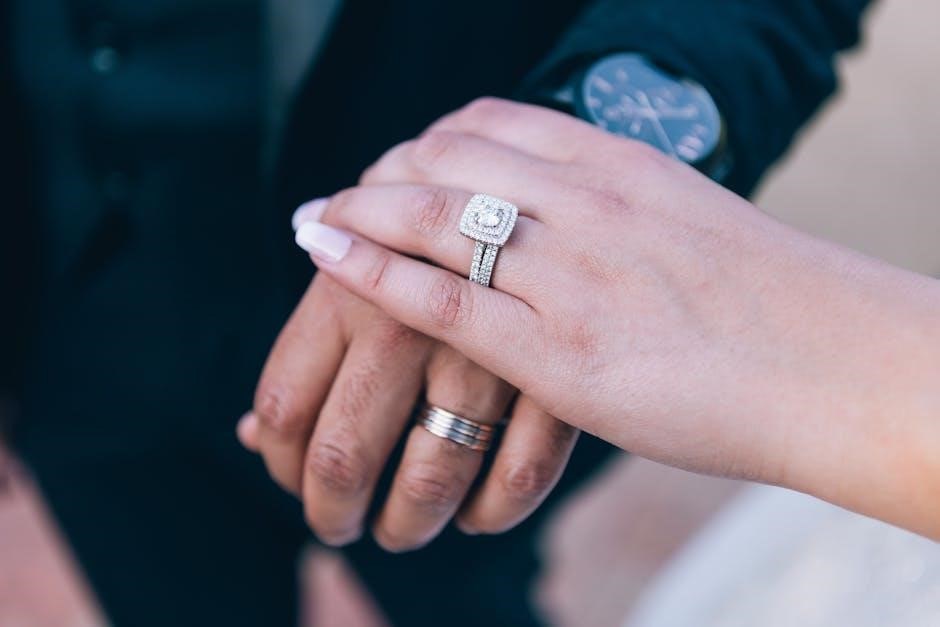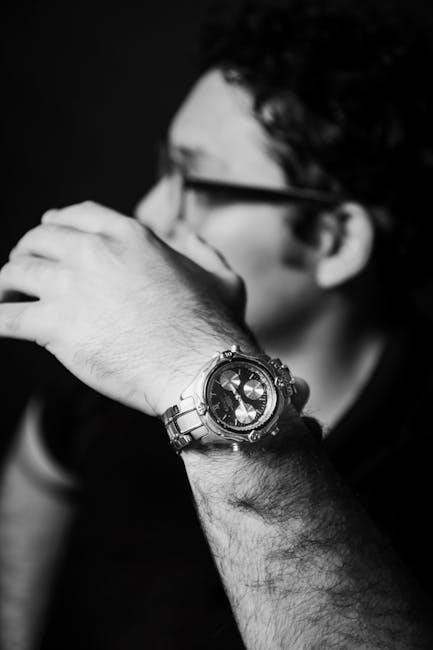A comprehensive guide to selecting the perfect watch band size, ensuring optimal comfort and style. This guide helps you understand sizing basics, measurements, and factors influencing fit.
1.1 Importance of Proper Fit
A proper watch band fit ensures comfort and enhances the watch’s appearance. A snug yet not overly tight band prevents discomfort and movement issues. Correct sizing also maintains the watch’s aesthetic balance, making it look proportional to your wrist. Ill-fitting bands can cause irritation or a mismatched style, emphasizing the need for accurate measurements and suitable materials for a seamless wearing experience.
1.2 Overview of Watch Band Sizes
Watch band sizes vary by width, length, and material, catering to diverse wrists and styles. Common widths range from 14mm to 24mm, while lengths adjust to fit small, medium, or large wrists. Bands are made from leather, metal, or rubber, offering options for both casual and formal settings. Standard size charts guide measurements, ensuring a perfect fit for any watch enthusiast’s needs.
Understanding Watch Band Sizing
Watch band sizing involves measuring width, length, and thickness to ensure a comfortable and stylish fit, tailored to individual wrist dimensions and watch case specifications.
2.1 Definitions: Length, Width, and Thickness
Length is the total strap measurement, ensuring comfort around the wrist. Width refers to the band’s measurement between the lugs, typically half the watch case diameter. Thickness affects durability and style, ranging from slim to robust designs.
2.2 How Band Size Affects Comfort and Appearance
Band size significantly impacts both comfort and appearance. A well-fitted strap ensures the watch sits securely without causing irritation, while an ill-fitting band can lead to discomfort. Proper sizing also enhances the watch’s aesthetic appeal, balancing proportions with the wrist and case. The right dimensions ensure a sleek, polished look, making the watch a perfect accessory for any style.
How to Measure Watch Band Size
Measuring watch band size involves determining width between lugs and calculating strap length. Use a millimeter bar or flexible ruler for accurate sizing to ensure a proper fit.
3.1 Measuring Band Width
To measure band width, place a millimeter bar between the watch’s lugs. The width is the distance between the inner edges where the band attaches. Common widths include 18mm, 20mm, and 24mm. Ensure the bar fits snugly without forcing it, as this provides the most accurate measurement for a proper fit and comfortable wear. This step is crucial for selecting the right strap size.
3.2 Calculating Band Length
Band length is determined by wrist circumference, ensuring a comfortable and secure fit. Standard lengths are categorized as Small, Medium, or Large, corresponding to wrist sizes. Small fits wrists from 14;5cm to 17cm, Medium from 16.5cm to 19cm, and Large from 18.5cm to 21cm. Many bands are adjustable or feature buckles for precise fitting, ensuring optimal comfort and security.
3.3 Using Wrist Circumference for Size
Wrist circumference is a key factor in determining the ideal watch band length. Measure around the wrist with a flexible tape or string, ensuring a snug fit. Standard size charts categorize wrist sizes as Small (14.5cm–17cm), Medium (16.5cm–19cm), and Large (18.5cm–21cm). This measurement ensures the band length is comfortable and secure, providing a perfect fit for your watch.

Factors Influencing Watch Band Size
Wrist size, shape, and watch case diameter significantly impact band size. Lug width ensures proper fit, while material and style affect comfort and aesthetic appeal.
4.1 Wrist Size and Shape
Your wrist size and shape are crucial for determining the ideal watch band fit. A smaller wrist requires a narrower band, while larger wrists accommodate wider styles. The shape, whether slim or robust, also influences how the band sits comfortably. Measuring wrist circumference ensures the band isn’t too tight or loose, enhancing both comfort and appearance.
4.2 Watch Case Diameter and Lug Width
The watch case diameter and lug width directly impact band size. The band must align with the lugs, which are the protrusions holding the strap. A wider case requires a broader band, ensuring a balanced look. Proper alignment prevents the band from appearing too bulky or too narrow, maintaining aesthetic harmony and functionality. Measure the lug-to-lug distance for accurate sizing.
4.3 Material and Style of the Band
The material and style of the band significantly influence size and comfort. Leather bands offer a classic look, while metal bracelets provide durability. Rubber straps are ideal for sports. The style should complement the watch case, ensuring a cohesive design. Material choice affects breathability, flexibility, and weight, making it crucial for long-term wearability and aesthetic appeal. Always choose a band that matches your lifestyle and preferences.

Standard Watch Band Sizes
Standard watch band sizes range from 18mm to 24mm in width, with lengths varying by wrist size. Common sizes include 40mm, 42mm, and 44mm case diameters, ensuring a universal fit for most wrists.
5.1 Common Width and Length Measurements
Watch bands typically range in width from 18mm to 24mm, correlating with the watch case size. Lengths vary based on wrist circumference, with standard sizes categorized as Small (14.5-17cm), Medium (16.5-19cm), and Large (18.5-21cm). These measurements ensure a snug, comfortable fit for diverse wrist sizes and watch styles, accommodating both casual and formal wear seamlessly.
5.2 Size Charts for Different Wrist Circumferences
Size charts categorize wrist circumferences into Small (14.5-17cm), Medium (16.5-19cm), and Large (18.5-21cm). These charts help determine the ideal band length for a comfortable fit, ensuring the watch sits securely without being too tight or loose. By referencing these guides, users can easily find a band that complements their wrist size and enhances both comfort and appearance.
Choosing the Right Watch Band Size
Selecting the right watch band size ensures comfort and style. Proper fit enhances wrist comfort and aesthetic appeal, making it essential for everyday wear and special occasions.
6.1 Matching Band Width to Watch Case
Matching the band width to the watch case is crucial for a seamless look. The band width should align with the case’s lug width, typically half the case diameter. Proper alignment ensures a balanced appearance, enhancing both comfort and style. This harmony is key to achieving a polished and cohesive design for your timepiece.
6.2 Selecting Length Based on Wrist Size
Selecting the right band length ensures a comfortable and stylish fit. Measure your wrist circumference to determine the appropriate length. Small wrists (14.5–17cm) suit shorter bands, while medium (16.5–19cm) and large (18.5–21cm) wrists require longer straps. Proper sizing prevents the watch from feeling too tight or slipping off, ensuring optimal comfort and a polished appearance.
6.3 Considering Band Material and Style
Band material and style significantly impact comfort and aesthetics. Leather straps are ideal for formal looks, while silicone or rubber bands suit active lifestyles. Metal bracelets offer durability and a sleek appearance. Consider your daily activities and personal style when choosing materials. Ensure the band’s texture and design complement the watch case for a cohesive look. Proper material selection enhances both functionality and visual appeal.

Manufacturer-Specific Size Guides
Manufacturers like Apple provide detailed sizing guides for their watch bands, ensuring a perfect fit. Other brands also offer specific charts to help customers choose the right size.
7.1 Apple Watch Band Sizing
Apple offers a sizing guide to ensure the perfect fit for their watch bands. With various sizes available, Apple’s guide helps users measure their wrists accurately and select the appropriate band length. This ensures comfort and style, whether for the Apple Watch Series or SE models, providing a tailored experience for every user.
7.2 Other Popular Watch Brands’ Size Charts
Brands like Timex and Carl Friedriks offer detailed size charts to help users find the perfect fit. These guides often include wrist circumference measurements and band width options. For example, Timex provides strap length guides based on wrist size, while Carl Friedriks offers bands in specific lug widths like 18mm, 20mm, and 24mm. These resources ensure comfort and style for various wrist sizes and preferences.

Adjusting and Fitting the Watch Band
Adjusting your watch band ensures a comfortable and secure fit; Start by assessing the band’s length and material. For metal bands, you may need to remove links using a screwdriver or specialized tool. Leather bands might require resizing or conditioning. Always use a soft cloth to prevent scratching. After adjusting, test the fit by ensuring the watch is snug but not too tight. Regular maintenance, like cleaning or conditioning, keeps the band in good shape. Adjustments can often be done at home, but complex bands may require professional assistance. The goal is to achieve a balance between security and comfort for optimal wearability. Proper fitting enhances both the functionality and aesthetic appeal of your watch. By following these steps, you can enjoy a perfectly tailored fit for your wrist.
8.1 Tips for Perfecting the Fit
For a perfect fit, measure your wrist accurately and compare it to the band’s length. Ensure the watch isn’t too tight or loose. Adjust metal bands by removing links, while leather bands may need conditioning. Test the fit by sliding your finger between the band and wrist. Proper adjustments ensure comfort and style, making your watch wearable all day without discomfort or restriction.
8.2 Tools and Techniques for Adjustment
Use spring bar tools to remove or adjust metal bands. For leather straps, consider conditioning for flexibility. Screwdrivers are essential for resizing metal links. Utilize a ruler to measure precise adjustments. Some bands may require specialized tools, like pin removal devices. Regularly clean and maintain adjustable parts to ensure smooth resizing. Proper techniques ensure a secure, personalized fit without damaging the watch or band material.
Maintenance and Care of Watch Bands
Regularly clean and condition your watch bands to maintain their quality. Store them in a dry place to prevent damage and extend their lifespan.
9.1 Cleaning and Conditioning
Regularly clean your watch band with mild soap and water to remove dirt and oils. For leather bands, use a soft cloth and avoid harsh chemicals. Metal bands can be polished with a jeweler’s cloth, while rubber bands can be washed with warm water. Allow bands to air dry to prevent moisture buildup and extend their lifespan.
9.2 Storing Watch Bands Properly
Store watch bands in a cool, dry place to prevent damage. Use a soft cloth or box to protect leather bands from dust and sunlight. Metal bands can be kept in individual pouches to avoid scratching. For rubber bands, ensure they are clean and dry before storing. Avoid extreme temperatures or humidity to maintain their condition and longevity.
A properly fitted watch band enhances comfort and style. Consider wrist size, watch case, and band material for the perfect fit, ensuring longevity and a polished look.
10.1 Key Takeaways
Understanding your wrist size, watch case dimensions, and band material is crucial. Proper fit ensures comfort, style, and durability. Always measure accurately and refer to manufacturer guides for optimal results. Adjusting and maintaining bands can extend their lifespan. Experiment with styles to personalize your look, ensuring a seamless match between band and watch for every occasion. Prioritize quality and fit for lasting satisfaction and versatility.
10.2 Final Tips for a Perfect Fit
Always measure your wrist accurately and consider the watch case size. Choose bands that match your lifestyle, whether leather for elegance or rubber for durability. Adjust straps for a snug, not tight, fit. Regularly clean and condition materials to maintain quality. Store bands properly to prevent damage. Experiment with styles to find what suits you best, ensuring a perfect balance of comfort and aesthetics.



0 Comments